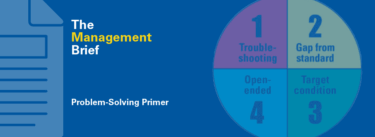Dear Gemba Coach,
I’m an OD coach interested in lean, and wonder how lean is different from creating a culture of problem solving?
Indeed. Culture is tricky term because it’s hard to define. Let’s think about culture broadly in terms of “what we think and do about things.” This leads us to ask two questions:
- What do we think is a problem (as opposed to what is not)?
- What do we do about a problem (as opposed to what we don’t do)?
Most business will argue that they have a culture of problem-solving – the question is what kind of problems and what kind of solving.
I was invited to visit a company recently, and the management team kindly took me to lunch in the management dining room. When I asked why they had a different lunch area from the rest of the employees, they answered that management time was a rare resource, so there was no time to waste queuing in the cafeteria. A management-only restaurant (with catering staff) was the solution. Here we see clearly problem-solving going on, but not lean in any way. Lean would consider that:
- Daily contact between management and employees is critical to teamwork and mutual trust – people need to see each other face-to-face and openly discuss problems as well as social chitchat to build trust (the lean problem). So, a common cafeteria with common queues (the solution) works, even though the real problem is: why queues in the first place.
- A specific area that only caters to management with dedicated staff is not a lean solution in any situation because it means over-investing in a non-flexible solution.
Interestingly, during the gemba visit, the management team showed me many efforts they’d done to guarantee productivity with lean tools. They tracked hourly production and responded quickly to issues. They worked on eliminating waste from operator movements, and had done many kaizen workshops to study standardized work and reduce wasted motion.
Absolutely lean problems and problem solving.
They also had very little to show on quality problem solving, flexibility (changeover time reduction and batch size reduction), and operator training issues. Again: what is a problem, and what is not? What is a solution and what is not?
What Is a Problem?
Lean is very specific in terms of what problems are. Most lean tools are about revealing problems in terms of:
- Increasing value in production and in engineering (safety, quality, flexibility, cost, morale, energy performance).
- Reducing lead time to reveal problems in delivery (mostly lack of flexibility and cooperation).
- Not letting defects move on to the next step in the process and reacting faster to every defect spotted.
- Better leveling of planning the workload.
- Deeper involvement of work teams on knowing their standards and improving their own ways of working.
- Continuously building on mutual trust between employees and management by supporting individuals in reaching the fullest of their abilities, supporting teams in owning their workspaces and making sure all enabling systems perform for frontline teams.
Lean is also very specific in terms of what to do about problems when they’ve been recognized. Problems are not to be solved by administrative or managerial solutions. Problems are to be solved by teaching the frontline team to better handle their work environment so that they solve the problem themselves (with, of course, enabling support from management.
In this sense, adding a quality control, an audit, a process, a committee and so on are NOT lean problem solving. Teaching an operator to better use a tool, getting the toolmaker to show up on the spot when there is a problem with the tool and fixing it, finding a different way to use the tool as a team – these would be lean solutions, or, in lean terminology “countermeasures.” (No problem is truly solved until the root cause is addressed, which means that the conditions creating the problem have been changed and the problem no longer occurs.)
Certainly, creating a culture of problem-solving is part of lean. Actually, “problems first” – encouraging unfavorable information and facing problems – is a key part of lean. But, conversely, not every culture of problem-solving is lean. Lean is very specific in the way it considers problems (a gap to standard – without a standard, a problem is an “issue”) and what kind of action it expects (making the team member more self-reliant and asking why until the root cause of the problem is eradicated).
Compared to most executive coaching, lean problem solving tends to be far more specific in how the problem is defined and what kind of countermeasures are sought This has the huge implication that the coach must grasp the key technical issues in the job of the coachee in order to orient the reflection. Asking “why?” in lean coaching, usually comes after pointing at a very specific issue. Point at a problem, then ask “why?” – the first step, however, is knowing what to point at, which is both the challenge and fun of lean’s unique brand of coaching.






